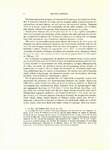| dc.description.abstract | THE ORPHIC PAPYRUS ROLL OF THESSALONICA
(Plates 12-15) In the course of an excavation of tombs conducted by the Greek Archaeological
Service at Derveni, a site about 10 km. North of Thessalonica, in the first months of
1962, among the remnants of the funeral pyre of tomb A was found a carbonized
Greek papyrus roll. This is the first manuscript on papyrus to have been discovered so
far in the soil of the Greek metropolis as against the thousands of similar finds
coming from Herculanum, Egypt or Palestine. Unfortunately the roll was not
found intact. Only its upper part, 7-8 cm. high, had been preserved, the rest
of it having apparently been destroyed by the fire. The impossible task of unrolling
the extremely fragile object was carried out by Mr. Anton Fackelmann, conservator
of the Vienna National Library collection of papyri, who finally succeeded,
by using juice of fresh papyrus, in making the carbonized roll manageable. Thus
the text became accessible for decipherment and further investigation.
The importance of the new manuscript lies chiefly in its early date. A comparison
of its writing with that of the oldest known papyri coming from the last decades
of the IVth century (particularly that of the Timotheos papyrus), as well as
with the inscriptions of the same century suggests that the new roll was written
about the middle of the IVth century B.C. If this is true, as I firmly believe despite
some doubts expressed by other scholars, this roll must be the oldest Greek manuscript
now in existence. Moreover its neat appearance is significant in that it
proves that by this time a real Buchschrift had been developed in Greece, whereas
in Egypt even later Greek literary papyri were written in clumsy and rather crude
hand (cf. W. Schubart, Einleitung in die Papyruskunde, Berlin 1918, p. 30).
The unrolling gave only a series of small and large fragments and several tiny
scraps. However the relation of most of these fragments between each other have
now been established, and this has been partly feasible thanks to the young photographer
Mr. Spyros Tsavdaroglou, who supplied us with excellent photographs.
In this task as well as in the decipherment of the text, in many places obscure and
desperately damaged, I largely profited by the palaeographic and scholarly experience
of my assistant Mr. K. Tsantsanoglou. Twenty two columns can now be
recognized with certainty. As the place of a few fragments and scraps has not yet
been identified we cannot say how many columns the roll contained originally.
The number of the lines preserved differs from column to column ranging from
eleven to sixteen; but the last lines generally present large gaps. The number of
lines contained in the lower part of the roll, now lost, cannot actually be reckoned.
It should be noted that the continuation of the text in subsequent columns is
very rarely obvious. The length of the lines varies between thirty one to
forty two letters, the copyist finishing each line with a full word or, exceptionally,
with the first component of a compound. The style of the script is the same
throughout the text, but after the seventh column a finer calamos was employed.
The text is an allegorical commentary on an Orphic poem of cosmogenic and
theogenic content. Eighteen verses of this poem are quoted separately, marked by the
sign of paragraphos, while other words or phrases are inserted in the text of the commentary
itself. This poem, alluded to by Plato (Laws 713e), was known from Ps. - Aristotle’s
de Mundo 1 (401a25) and appears later on in an expanded form in the socalled
Rhapsodic Theogony (ιεροί λόγοι εν ραψωδίαις κδ'). Since the time of the
composition of the Orphic Theogony is uncertain, the new text will probably cast
new light on this puzzling problem.
Besides the Orphic verses the commentator quotes three Homeric verses (also instructive for the tradition of the Homeric text) in order to corroborate his explanation
of a word of the poem commented on by him. For it is a feature of this
author’s method to combine allegoric interpretation with lexical explanations.
However this method of lexical explanation and quotation of verses does not prove
that this commentary is in any way connected with Alexandrian scholarship. Even
if the date of the new roll permitted such a hypothesis, the fact that here the main
point is the allegoric interpretation, which was alien to Alexandrian scholarship,
excludes any connection with the latter. Here another tradition, that of allegoric
interpretation of poetry, which appears already in the Vlth century, is in operation.
There is evidence that allegoric interpreters pursued lexical explanation (an
example is offered by Metrodoros from Lampsacus). The language of this text,
which contains poetic and Ionic forms, makes it probable that the commentator
of the Orphic poem, like other allegorists, did not come from Athens but from the
periphery of the Greek world. Yet nothing is certain about his identity. Epigenes
who is stated to have written On Orpheus' Poetry (Clem. Al. Strom. I 21, 131, 5 = II
81, 11 St.) and explained the expressions of Orphic symbolism [ibid. V 8, 49, 3 =
360, 10 St.), though seemingly not unfamiliar with lexical explanation (cf. Athen.
468c) should be excluded since the allegoric explanations of this commentary are
quite different from his own. | en |



